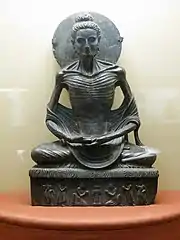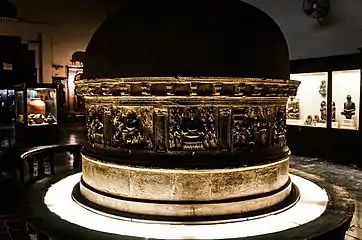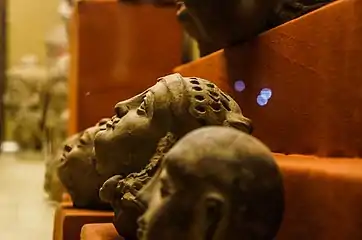لہور میوزیم عجائب گھر لاہور | |
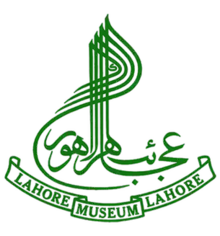 | |
 Entrance to the museum | |
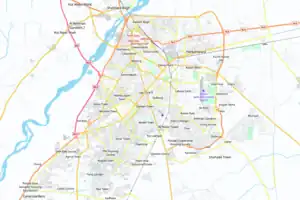 Location within Lahore | |
Former name | Central Museum |
|---|---|
| Established | 1865, moved to present site in 1894 |
| Location | The Mall, Lahore, Punjab, Pakistan |
| Coordinates | 31°34′06″N 74°18′29″E / 31.568226°N 74.308174°E |
| Type | Archaeology, art, heritage, modern history, religious |
| Collection size | 58,000 |
| Visitors | 227,994 (2018) |
| Director | No one |
| Curator | Naushaba Anjum |
| Public transit access | Civil Secretariat, Lahore Metrobus |
| Website | Official website |
The Lahore Museum (Punjabi: لہور میوزیم; Urdu: عجائب گھر لاہور; "Lahore Wonder House") is a museum located in Lahore, Punjab, Pakistan. Founded in 1865 at a smaller location and opened in 1894[1] at its current location on The Mall in Lahore during the British colonial period, Lahore Museum is Pakistan's largest museum, as well as one of its most visited ones.[2][3][4]
The museum houses an extensive collection of Buddhist art from the ancient Indo-Greek and Gandhara kingdoms. It also has collections from the Indus Valley Civilisation, Mughal Empire, Sikh Empire and the British Empire in India.[5]
The Lahore Museum, along with the Zamzama Gun located directly in front of the building, is the setting of the opening scene in the novel Kim by Rudyard Kipling,[6][7] whose father, John Lockwood Kipling, was one of the museum's earliest curators.[8]
History

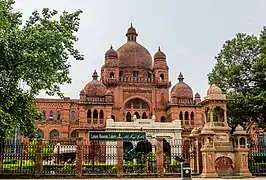

Lahore Museum was originally established in 1865–66 on the site of the current Tollinton Market – a hall built for the 1864 Punjab Exhibition.[9] The present building was constructed as a memorial of Golden Jubilee of Queen Victoria held in 1887, and financed through a special public fund raised on the occasion. The foundation stone of the new museum was laid on 3 February 1890 by Prince Albert Victor, Duke of Clarence, Queen Victoria's grandson. On its completion in 1894, the entire museum collection was transferred to present building with its new name as Jubilee Museum.
The museum's collection was shifted in 1894 to its present location on The Mall, in Lahore's British-era core.[1] The present building was designed by the well-known architect from Lahore, Sir Ganga Ram.[4]
Rudyard Kipling’s father, John Lockwood Kipling, was one of the museum's first curators, and was succeeded by K. N. Sitaram.
In 1948, as part of the partition of Punjab, the artefacts of the museum were divided between the newly formed countries of Pakistan and India, with the museum retaining about 60% of its collection. The rest was given to India and eventually housed at the Government Museum and Art Gallery in Chandigarh, built specifically for this purpose.[10]
The museum's golden years are considered to be from 1970 to 1990, when scholar, archaeologist, and museologist Dr Saif-ur-Rehman Dar served as its director. He wrote several books about the museum, and his tenure was complemented by that of B.A. Qureshi, who was the chairman of the museum's board of governors back then.
After that, the condition of the museum went deteriorated due to the lack of support for its restoration.
Over 250,000 visitors were registered at the Lahore Museum in 2005. This dropped to 236,536 in 2016, 214,697 in 2017, but rose to 227,994 in 2018. It was the most popular museum of Pakistan among foreigners in 2016 (2,956 visits) and 2017 (2,941 visits). It dropped to second place (with 3,659 foreign visitors) in 2018, having been replaced by Taxila Museum.[11]
Scope

The museum displays archaeological materials from Bronze Age (Indus Valley Civilisation) to the medieval era Hindu Shahi & Mughal period.[5] It has one of the largest collections of archaeology, history, arts, fine arts, applied arts, ethnology, and craft objects in Pakistan. It also has an extensive collection of Hellenistic and Mughal coins.[1] There is also a photo gallery dedicated to the emergence of Pakistan as an independent state, the Pakistan Movement Gallery.[5]
Collections
The museum has a number of Greco-Buddhist sculptures, Mughal and Pahari paintings on display.[1] Over 58,000 artifacts are reported to be part of its collection, with only 14,000 being on display.[12] The collection contains important relics from the Indus Valley civilization, Gandhara, and Graeco-Bactrian periods as well. The Fasting Buddha, dating from the Gandhara period, is one of the museums most prized and celebrated objects.
The coin collection consists of 38,000 rare coins.[12]
The Evolution of Mankind
The ceiling of the entrance hall features The Evolution of Mankind, a large mural consisting of 48 panels (each measuring 6 by 8 feet). It was painted by Pakistani artist Sadequain who originally completed it in 1973.[5][13][14] Due to the weather conditions and termite attacks, the mural suffered significant damage over the years, A grant was approved by the Governor of Punjab in 2008 to start the restoration work. It was taken down in 2010, while restoration work began in 2012.[15] By 2018, 16 of the panels had been restored by Uzma Usmani and Mumtaz Hussain.[16]
The museum also contains fine specimens of Mughal and Sikh carved woodwork and has a large collection of paintings dating back to the British period. The collection also includes musical instruments, ancient jewelry, textiles, pottery, and armory, as well as some Tibetan and Nepalese work on display.[1][5]
Directors
The following is a list of the museum's directors.[17]
| No. | Name | Role | Position | Duration
(years) |
Ref. |
|---|---|---|---|---|---|
| 1 | John Lockwood Kipling (C.I.E) | Curator | 1875–1893 | 18 | |
| 2 | Fred Henry Andrews | Curator | 1893–1899 | 6 | |
| 3 | Percy Brown | Curator | 1899–1912 | 13 | |
| 4 | Hugh Lionel Heath | Curator | 1912–1929 | 7 | [18] |
| 5 | Rai Bahadur (S.N. Gupta) | Curator | 1929–1942 | 13 | |
| 6 | Molvi Zarar Hasan | Curator | 1942–1947 | 5 | |
| 7 | Malik Shams | Curator | 1947–1965 | 18 | |
| 8 | Syed Muhammad Taqi | Curator/Director | 1965–1974 | 9 | |
| 9 | Dr. Saifur Rehman Dar | Director | 1974–1993 | 19 | [4] |
| 10 | Dr. F.M. Anjum Rehmani | Officiating Director | 1993–1995 | 2 | |
| 11 | Dr Saif-ur-Rehman Dar, | Director | 1995–1998 | 3 | |
| 12 | Dr. F.M. Anjum Rehmani | Officiating Director | 1998–2001 | 3 | |
| 13 | Mansoor Sohail | Director (Additional charge) | 2000–2001 | 1 | [12] |
| 14 | Dr. Liaquat Ali Khan Niazi | Director | 2001–2004 | 3 | [19] |
| 15 | Syed Gulzar Mashhadi | Director | 2004–2005 | 1 | |
| 16 | Naheed Rizvi | Director | 2005–2008 | 3 | [20] |
| 17 | Asghar Nadeem Syed | Director | 2008–2009 | 1 | [21] |
| 18 | Dr. Kamran Afzal Cheema | Director | 2009–2009 | <1 | |
| 19 | Muhammad Siddique Sheikh | Director | 2009–2010 | 1 | |
| 20 | Salman Ijaz | Director | 2010–2010 | <1 | |
| 21 | Humera Alam | Director | 2010–2012 | 2 | [22] |
| 22 | Sumaira Samad | Director | 2012–2016 | 4 | |
| 23 | Syed Tahir Raza Hamdani | Director (Additional charge) | 2016–2016 | <1 | |
| 24 | Humayun Mazhar Sheikh | Director | 2016–2018 | 2 | [16] |
| 25 | Saman Rai | Director (Additional charge) | 2018–2019 | 1 | [23] |
| 26 | Nasir Jamal Hotiana | Director | 2019–2019 | <1 | |
| 27 | Tariq Mahmood Javaid | Director | 2019–2020 | 1 | [24] |
| 28 | Ijaz Ahmed Minhas | Director | 2010–present | 2* | [25] |
Book
The book Masterpieces of Lahore Museum, written by Anjum Rehmani, was published by the museum in 1999 with financial assistance from UNESCO.[26] A new edition was published in 2006.[27]
In popular culture
- Rudyard Kipling's novel, Kim (published in 1901), was set in the vicinity of the old/original Lahore Museum and the Mall areas.
Further reading
- Shaila Bhatti (2012), Translating museums: a counterhistory of South Asian museology, Walnut Creek, Calif: Left Coast Press, ISBN 9781611321449
- Whitehead, Richard Bertram (1914). Catalogue of Coins in the Panjab Museum, Lahore; Indo-Greek Coins : Volume 1. The Panjab Government at The Clarendon Press, Oxford.
- Whitehead, Richard Bertram (1914). Catalogue of Coins in the Panjab Museum, Lahore; Coins of Mughal Emperors: Volume 2. The Panjab Government at The Clarendon Press, Oxford.
See also
References
- 1 2 3 4 5 "Lahore Museum | museum, Lahore, Pakistan | Britannica". www.britannica.com. Retrieved 14 July 2022.
- ↑ "Tourism boom: Foreigners visiting cultural sites, museums in Pakistan up by 121%". The Express Tribune. 30 September 2019. Retrieved 14 July 2022.
- ↑ Akhtar, Anwar (7 July 2020). "Pakistan's Best Kept Secret: Lahore Museum". www.salzburgglobal.org. Retrieved 14 July 2022.
- 1 2 3 Tariq, Minahil (22 January 2017). "A historic neglect | Shehr | thenews.com.pk". The News International. Retrieved 14 July 2022.
- 1 2 3 4 5 "AROUND TOWN: Lahore Museum". Dawn. 31 October 2008. Retrieved 7 September 2021.
- ↑ Kaplan, Robert D. (29 January 1989). "Lahore as Kipling Knew It". The New York Times. ISSN 0362-4331. Retrieved 14 July 2022.
- ↑ Jordison, Sam (19 January 2016). "Rudyard Kipling's Kim: a zam-zammer wonder-house of wordplay". The Guardian. Retrieved 14 July 2022.
- ↑ "V&A · Research project: John Lockwood Kipling". Victoria and Albert Museum. Retrieved 14 July 2022.
- ↑ Which later became the Tollinton Market after the completion of the new/present museum building, see "Murray's Handbook of the Punjab", pub. 1883. Mention also made in Peter Hopkirk, "Quest for Kim", London, 1996, pp.46–47 ISBN 0-7195-5560-4
- ↑ Shukla, Vandana (30 September 2018). "One foot in Lahore, the other in Chandigarh: How Partition's sundering affected a museum's artifacts". Firstpost. Retrieved 5 November 2021.
- ↑ "Cultural Heritage & Museum Visits in Pakistan". Gallup Pakistan. Retrieved 14 July 2022.
- 1 2 3 Hanif, Intikhab (27 March 2002). "Museum unable to display its 'treasure'". Dawn. Retrieved 14 July 2022.
- ↑ Bhatti, Arshad (18 September 2012). "Museum to conserve Sadequain's mural". The Nation. Archived from the original on 8 November 2019. Retrieved 7 September 2021.
- ↑ Chishti, Rabia; Naz, Salma; Mujeeb, Zile Huma; Seemi, Imrana (30 December 2016). "The Evolution of Mankind: A Gigantic Mural by Sadeqauin". Archived from the original on 1 October 2022. Retrieved 14 July 2022.
{{cite journal}}: Cite journal requires|journal=(help) - ↑ Malik, Sonia (9 September 2012). "Sadequain mural: Long process of restoration begins". The Express Tribune. Retrieved 14 July 2022.
- 1 2 Ahmed, Shoaib (27 February 2018). "Sadequain's mural panel to be displayed". Dawn. Retrieved 14 July 2022.
- ↑ "Our Directors | Lahore Museum". www.mapalytics.org. Retrieved 14 July 2022.
- ↑ "Heathhughlionel1938 - JJHC". jjhc.info. Retrieved 14 July 2022.
- ↑ "Difference that counts". Dawn. 12 June 2003. Retrieved 14 July 2022.
- ↑ "Asia Pacific parliamentarians visit Lahore Museum". Business Recorder. 28 February 2007. Retrieved 14 July 2022.
- ↑ Khan, Muttahir Ahmed (13 February 2022). "On life and art". The Express Tribune. Retrieved 14 July 2022.
- ↑ Malik, Sonia (24 August 2011). "Death anniversary tribute: Lahore Museum honours its first chairman". The Express Tribune. Retrieved 14 July 2022.
- ↑ Agha, Saira (15 February 2019). "Depicting the importance of women in society". Daily Times. Retrieved 14 July 2022.
- ↑ "Lahore Museum holds first-ever Sikh exhibition". The Express Tribune. 4 September 2019. Retrieved 14 July 2022.
- ↑ Ahmed, Shoaib (31 May 2022). "Lahore Museum to exhibit ethnological gallery artifacts". Dawn. Retrieved 14 July 2022.
- ↑ "Masterpieces of Lahore Museum – UNESCO Digital Library". unesdoc.unesco.org. Retrieved 10 September 2019.
- ↑ Rehmani, Anjum (1999). Masterpieces of Lahore Museum. Lahore Museum. OCLC 137232699.
External links
- Official website
- Official Facebook page
- Official Twitter page
- Lahore Museum at Google Cultural Institute
